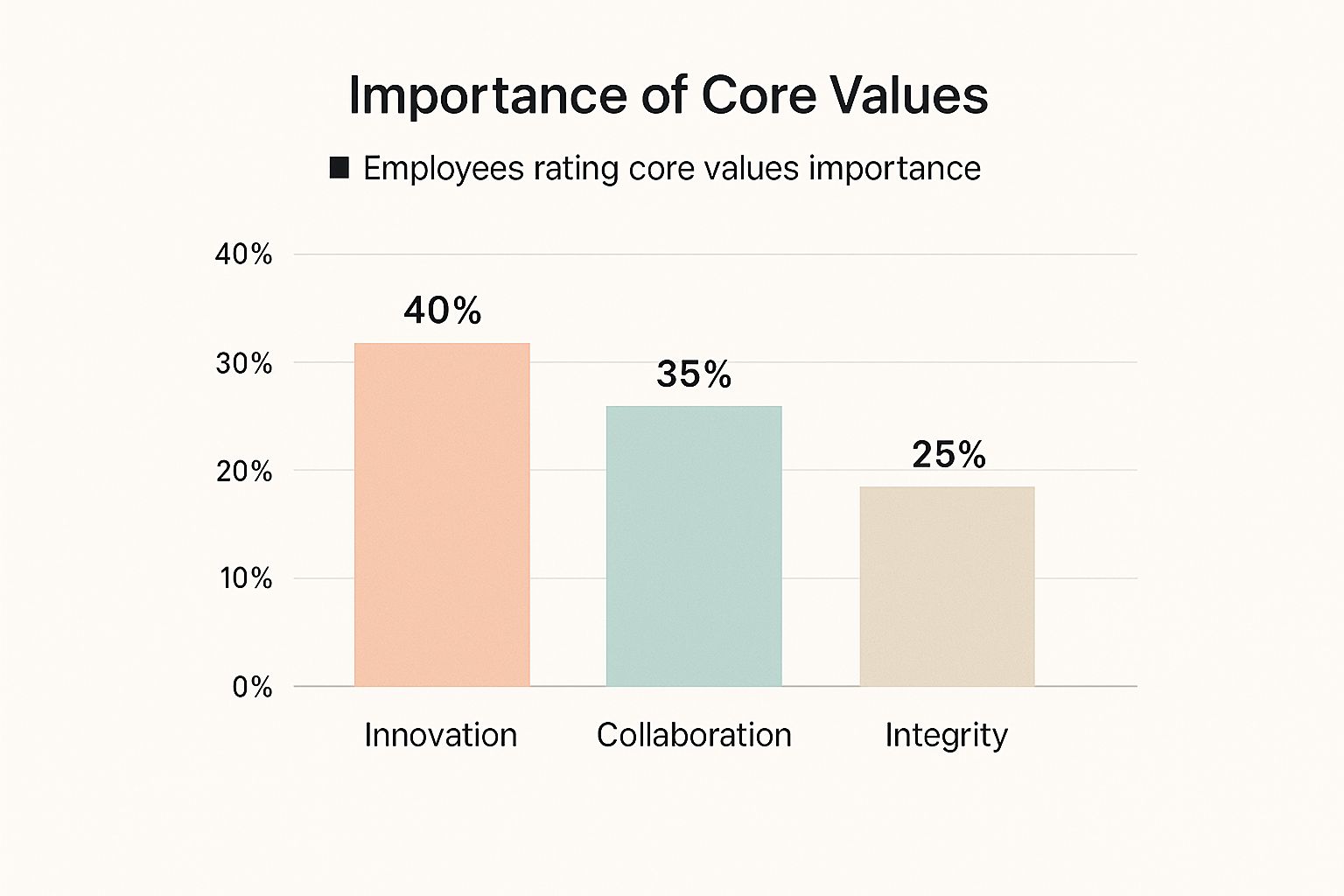Company culture isn't just a mission statement hanging on the wall. It's the sum of countless daily actions—it’s how you define and live your core values, encourage open communication, and celebrate the behaviors that move you forward together. Culture thrives when every single person on the team feels seen, heard, and connected.
Building Your Authentic Culture Blueprint
Before you can build a great culture, you need a blueprint. And I don't mean some generic list of values. A real blueprint is an authentic guide that reflects who your team truly is and steers every single business decision. It’s the living document that explains the 'how' and 'why' behind everything you do.
This isn't a top-down exercise, either. The best blueprints are created through honest conversations with everyone, from the C-suite to the newest hire. You need to dig deep to find out what really matters to the people who power your organization. Those discoveries become the very foundation of your culture.
✦Articulating Your Core Values
Once you've uncovered what's important, it's time to put it into words—clear, actionable words. "Be Awesome" sounds nice, but what does it actually mean? Get specific.
For example, if "Collaboration" is a core value, don't just leave it at that. Define it: "We actively seek diverse perspectives and share knowledge openly to achieve collective success."
This kind of clarity gives you a solid framework for:
- Hiring Decisions: You can hire for more than just skills; you can hire for culture fit.
- Daily Interactions: It gives everyone a shared language and expectations for how to work together.
- Performance Reviews: Feedback can be tied directly to whether someone's actions align with your core principles.
A huge part of this is building brand loyalty through a strong company culture. When your internal values shine through in your external brand, you create something powerful and cohesive.
Below is a table outlining the key pillars you'll need to define your own blueprint.
✦Table: Key Components of Your Culture Blueprint
| Component | Description | Example Action |
|---|---|---|
| Core Values | The fundamental beliefs that guide behavior and decisions. | Defining "Integrity" as "Always doing the right thing, even when no one is watching." |
| Mission & Vision | Your company's purpose (why you exist) and aspiration (where you're going). | A mission to "democratize financial data for everyone." |
| Communication Norms | The expected styles and channels for internal communication. | Committing to a "no-blame" approach in post-mortems to encourage honesty. |
| Recognition & Rewards | How you celebrate wins and acknowledge value-aligned behaviors. | Creating a peer-to-peer recognition program in a dedicated Slack channel. |
This blueprint serves as your North Star, ensuring every initiative, from hiring to project management, reinforces the culture you want to build.

This chart shows how employees might prioritize different company values. While innovation often gets the spotlight, you can see that a healthy culture really needs a balanced focus on things like collaboration and integrity, too.
✦The Real Cost of a Disconnected Culture
What happens if you skip this foundational work? The consequences are serious. A strong culture is directly linked to employee engagement, and the latest numbers are pretty grim.
As of 2025, a staggering 70% of employees globally feel disengaged at work—a ten-year low.
Think about that. Disengaged employees are not only 56% more likely to look for a new job, but they also cost their companies around 34% of their annual salary in lost productivity. Your culture blueprint is your best defense against this kind of costly disengagement. It's how you start building a place where people genuinely want to show up and do their best work.
Keeping Your Hybrid Team Connected
A strong company culture relies on connection, but let's be honest—that's a tough nut to crack when your team is spread out. The forced virtual happy hours of a few years ago are dead. To actually build real bonds, you need to plan inclusive activities that people want to join, whether they’re at a desk in the office or on their couch at home.
The secret? Make it ridiculously easy to participate.
Every extra click, every new app to download, every calendar invite someone has to manually accept—it’s all friction. When connecting feels like another task on the to-do list, people will tune it out. Your culture pays the price. You have to be deliberate about making it seamless.
✦Making Connection Effortless in the Hybrid World
The best way to do this is to bring social and team-building events into the tools your team already lives in all day. If your company runs on Slack and Google Calendar, you have a golden opportunity to make getting together so much easier. Forget sending mass emails that get buried or creating calendar events people ignore. Meet your team where they already are.
This isn’t just about having fun; it’s about creating a true sense of belonging. An inclusive and supportive workplace is your best defense against burnout and disengagement. The numbers don't lie: employees who feel connected to their team culture are 3.7 times more engaged and 68% less likely to burn out.
What’s more, highly engaged teams have 78% lower absenteeism and drive a 10% increase in customer ratings. A connected team directly impacts your bottom line.
✦A Game-Changer for Slack and Google Calendar Users
For companies that use both Slack for communication and Google Calendar for scheduling, this fragmentation is a major headache. This is exactly why a tool like Be-There is so useful and handy. It's built to bridge the gap between these two essential platforms, killing the logistical nightmare of planning events for hybrid teams. Think about it: planning a team lunch, a virtual coffee chat, or a project kickoff without ever leaving your primary communication hub.
Here’s how it works:
- Create Events Right in Slack: You can set up and post an event in the Slack channel where your team is already talking.
- One-Click RSVP: Team members just click a button to say they’re coming. No switching apps, no digging through emails.
- Automatic Calendar Sync: As soon as they RSVP in Slack, the event is automatically added to their Google Calendar. No more "I forgot to add it to my calendar" excuses.
This simple, integrated workflow completely removes the biggest headaches of hybrid event planning. If you want more tips for making things run smoothly, you can find them here: https://be-there.co/blog/articles/hybrid-meeting-best-practices.
You can see for yourself how straightforward it is to create an event right inside your Slack workspace.

The interface is clean and intuitive. You add the location, drop in an image, and write a quick description right where everyone will see it. By putting everything in one place, you make it almost effortless for people to show up. It’s a small change in process that makes a huge difference in building a culture where everyone feels like they truly belong.
Weaving Culture into Daily Workflows

Company culture isn't something you build during a few annual retreats or team-building days. It’s forged in the small moments and consistent actions that fill every single workday. The real litmus test for your company values is whether they actually show up in how you run meetings, manage projects, and communicate with each other.
If your culture deck preaches one thing but your daily reality is completely different, you end up with a credibility gap that breeds cynicism. To really make your culture stick, you have to weave it into your operations. Embracing tools like workflow automation can help by handling repetitive tasks, which frees up your team’s time for the kind of meaningful, creative work that truly builds culture. It's all about turning abstract ideals into concrete, everyday behaviors.
✦Aligning Recognition with Core Values
One of the most powerful tools you have for reinforcing culture is your recognition system. When you publicly celebrate the behaviors that reflect your core values, you send a crystal-clear message about what your company genuinely prioritizes. It’s not enough to just praise someone for high output; you need to highlight how they achieved it.
- Is "Collaboration" a core value? Then give a shout-out to the person who jumped in to help another department hit a tight deadline.
- Do you value "Innovation"? Celebrate the employee who took a calculated risk on a new idea, even if it didn't fully succeed. This shows that the process of trying is just as important as the outcome.
This approach makes your values real and tangible. It gives everyone a clear picture of what "living the culture" looks like in practice, which in turn encourages them to follow suit.
When employees see that management's actions align with its words, they are five times more likely to want to stick around for the long haul. That kind of trust is built on consistent, value-driven recognition.
✦Structuring Work to Reinforce Culture
Beyond just giving praise, the way you actually structure your work can either bolster or break your culture. Take a hard look at your team's core processes. Do they genuinely support the environment you’re trying to build? This is where you put your values into action.
For example, if "Transparency" is one of your key values, what does that look like during a project kickoff? It probably means sharing not just the project goals, but also the budget limitations and potential roadblocks with the entire team right from the start.
Think about making adjustments like these:
- Feedback: Move beyond simple top-down performance reviews. Implement peer-to-peer feedback channels to foster open communication and mutual respect.
- Meetings: If you value "Efficiency," then every single meeting should have a clear agenda, a designated owner, and defined goals. Always wrap up by summarizing the action items.
When you design them with intention, these everyday actions become the very foundation of a strong, authentic company culture. They take your values off the wall and embed them into the lived, daily experience of every single person on your team.
Fueling Growth and Employee Development
A culture that isn't growing is a culture that's dying. It's as simple as that. The best people out there aren't just looking for a paycheck; they're looking for a place to build a career. When you genuinely invest in your team's future, it's more than just a perk—it’s a powerful statement about your company's values.
This goes way beyond the occasional, generic training course. It’s about sending a consistent message that you believe in your team's potential and are ready to help them reach it. This commitment to development is a huge magnet for ambitious talent and a cornerstone of long-term retention.
✦Building Personalized Growth Pathways
Everyone on your team has different skills and career goals. A one-size-fits-all training program just feels impersonal and rarely hits the mark. What you really want is a culture where personalized growth plans are the standard.
Think of these plans as collaborative conversations, not top-down orders. You need to sit down with your people and map out where they want to go and what skills they'll need to get there. This shows you respect their individual ambitions and helps align their personal growth with the company's future needs.
- Mentorship Programs: Pairing your seasoned experts with newer team members is a game-changer. A solid mentorship program is one of the best ways to pass down institutional knowledge and build strong internal relationships.
- Upskilling Resources: Give your team access to real learning opportunities. This could be anything from online courses and industry certifications to hands-on workshops. When you provide the tools, you're showing you trust them to take ownership of their own development.
✦The Real Cost of Stagnation
The expectations people have for work have fundamentally changed. Employees are looking for more from their careers, and opportunities for growth are no longer negotiable. In fact, a staggering 40% of employees say they would quit if their employer didn't offer upskilling opportunities. This massive shift is something you can’t ignore, and you can discover more insights about these changing attitudes toward work on weforum.org.
A culture that ignores growth isn't just failing its employees; it's actively pushing them out the door. The message is clear: invest in your people, or watch them leave for a company that will.
Investing in your team’s growth pays off big time, leading to a more capable, motivated, and loyal workforce. It’s also a chance to live out your company values. Recognizing professional milestones is just as crucial as celebrating big project wins. If you're looking for ideas, our guide on effective employee recognition program examples is a great place to start.
When you foster a culture of continuous learning, you’re not just developing skills—you’re building your company's future leaders.
How to Measure and Evolve Your Culture

Your company culture isn't a project with a finish line. Think of it more like a garden; it needs constant attention to thrive. To guide its growth, you have to create a feedback loop that shows you what’s working, what’s falling flat, and where you need to adapt.
A common mistake is treating culture as a "set it and forget it" initiative. The reality is, you have to actively listen and keep a finger on its pulse. This means moving beyond the once-a-year survey and adopting more frequent, lightweight check-ins to get a real sense of how people are feeling.
✦Creating a Clear Feedback Loop
An evolving culture is built on a foundation of consistent feedback. You absolutely need to establish safe, reliable channels for your team to share what they're really thinking. Without that honest input, any changes you make are just shots in the dark.
Here are a few practical ways I’ve seen this work well:
- Regular Pulse Surveys: Keep them short and send them out monthly or quarterly. They're perfect for tracking key metrics over time and spotting trends before they blow up into major problems.
- Anonymous Feedback Channels: Something as simple as a dedicated Slack channel or an online form can create a safe space for people to voice concerns without worrying about judgment.
- "Ask Me Anything" (AMA) Sessions: Getting leadership in a room (or on a call) for regular AMAs does wonders for building trust. It shows you’re genuinely committed to open dialogue, not just paying it lip service.
This commitment to listening creates that powerful feedback loop. It's truly the only way to understand the employee experience and make smart decisions about how to make it better.
When employees believe management's actions align with their words, they are five times more likely to want to stay with the company long-term. That kind of trust is built by listening and then actually acting on what you hear.
✦Analyzing the Right Metrics
Feedback gives you the "why," but you still need data to show you the "what." To get the full picture of your culture's health, you need to track some key indicators that reflect how your team is feeling and acting.
Start by digging into metrics like these:
- Employee Turnover Rates: Are good people walking out the door? A high turnover rate is often the most glaring red flag that something is off with your culture.
- Engagement Scores: These scores, which you can gather from your pulse surveys, are a direct measurement of your team’s connection to their work and the company itself. For a deeper dive, check out our guide on how to measure employee engagement.
When you combine the qualitative feedback with these hard numbers, you can diagnose issues with real accuracy and focus your energy where it’ll actually make a difference. This data-informed approach is essential for any company that wants to build a culture that lasts. By involving your team in the process and being transparent about the changes you're making, you ensure your culture stays strong and relevant as you grow.
Common Questions About Building Company Culture
Even with the best roadmap, building a great company culture brings up a lot of questions. I hear these all the time from leaders who are in the trenches, trying to make a real difference. Here’s my take on some of the most common challenges.
✦How Long Does It Take to Build a Strong Company Culture?
Let's be realistic: there's no magic wand here. You can get the foundation in place—nailing down your values and kicking off a few key initiatives—in a couple of months. But to see that culture truly take root and become part of your company's DNA? You're looking at 1 to 2 years of consistent, dedicated effort.
Think of it like tending a garden. You can plant the seeds in a weekend, but the real work is in the daily watering, weeding, and nurturing. Your culture depends on the small, everyday actions of your leaders and how you collectively handle the tough moments. Persistence is the name of the game.
✦Can You Actually Fix a Toxic Company Culture?
Absolutely, but it’s not for the faint of heart. It requires a serious, top-down commitment and some tough decisions. The first step is always getting to the truth. You need to dig in and find the root causes of the toxicity through honest, and most importantly, confidential feedback channels.
From there, leadership has to be ready to act decisively. This isn't about lip service. It might mean tearing down broken processes, confronting toxic behaviors head-on, or even letting go of people who refuse to get on board. Rebuilding trust is a slow process, and it starts with radical transparency.
The biggest mistake I see is companies treating culture as an HR problem or a checklist of perks. A strong culture has to be owned by leadership and woven into every single thing the business does.
When leaders say one thing but their actions say another, it creates a culture of cynicism. Your real culture is defined by who you hire, who you promote, and who you let go.
✦What's the Easiest Way to Organize Culture-Building Events?
One of the biggest blockers to building culture isn't a lack of ideas—it's the sheer administrative pain of getting people together. Trying to coordinate invites, chase down RSVPs, and send out a dozen reminders just sucks up time that could be spent on much more important things.
This is especially true for teams living in Slack and Google Calendar, where event planning can quickly devolve into a chaotic mess of DMs and manual calendar invites. The whole process is so clunky that people just give up and don't show.
A simple fix is to use a tool that meets your team where they already are. For companies using both Slack and Google Calendar, an app like Be There is particularly useful because it completely streamlines the process:
- Create events right inside a Slack channel. No more context-switching or sending out separate emails that get lost.
- Let people RSVP with a single click. Team members can confirm they're coming instantly, without leaving the conversation.
- Automatically sync with Google Calendar. The event pops onto their calendar the second they RSVP, which means no more "I forgot!" excuses.
By taking the logistical headache out of it, you make it incredibly easy for people to participate. That's how you build real connections and strengthen your culture.
✦How Can a Small Startup Create a Good Culture?
A great culture has nothing to do with a big budget and everything to do with being intentional. Startups can build an amazing culture by focusing on the things that actually matter:
- Clear Values: Define what you stand for from day one.
- Open Communication: Make honesty and direct feedback the norm.
- Meaningful Recognition: Celebrate the wins, big and small, and do it publicly.
- Trust and Flexibility: Give your team the autonomy to do their best work.
At the end of the day, a culture built on respect, trust, and a shared mission will always beat one built on expensive perks.
Ready to make your culture-building events effortless? With Be There, you can create, manage, and boost attendance for all your team gatherings directly from Slack. Learn how to simplify your event planning today at https://be-there.co.

Planning your internal events has never been easier!
No more scheduling headaches—our Slack-connected web app keeps things simple. Less email, more fun! 🚀
